Submitted by WA Contents
Herzog & de Meuron proposes "horizontal skyscrapers" raised on stilts for Moscow's historic brewery
Russia Architecture News - Apr 14, 2018 - 03:16 22090 views
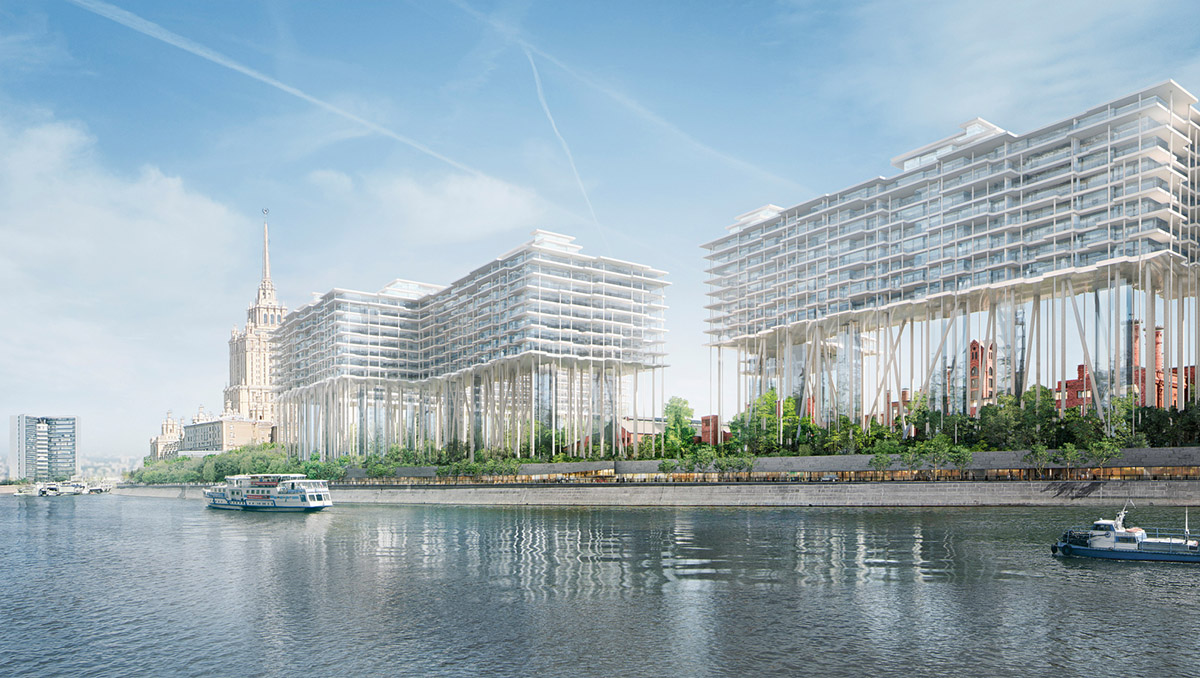
World-renowned Swiss firm Herzog & de Meuron has released design to redevelop the abandoned Badaevskiy Brewery in Moscow, the two apartment blocks - called as "Horizontal Skyscrapers"- will be raised on slender stilts on the six-hectare (60,000 square meters) former factory area in Moscow, which is located seven kilometers west from the Kremlin, at the shore of Moscow River.
The firm will open the old factory grounds and the embankment to the public by also restoring the heritage industrial structures and adding a new building to the redevelopment plans.
Herzog & de Meuron's design scheme aims to open a new public park beneath the apartment blocks that will be raised 35 metres above the ground on irregularly-arranged slender stilts, to create like "an elevated lodge in the forest."
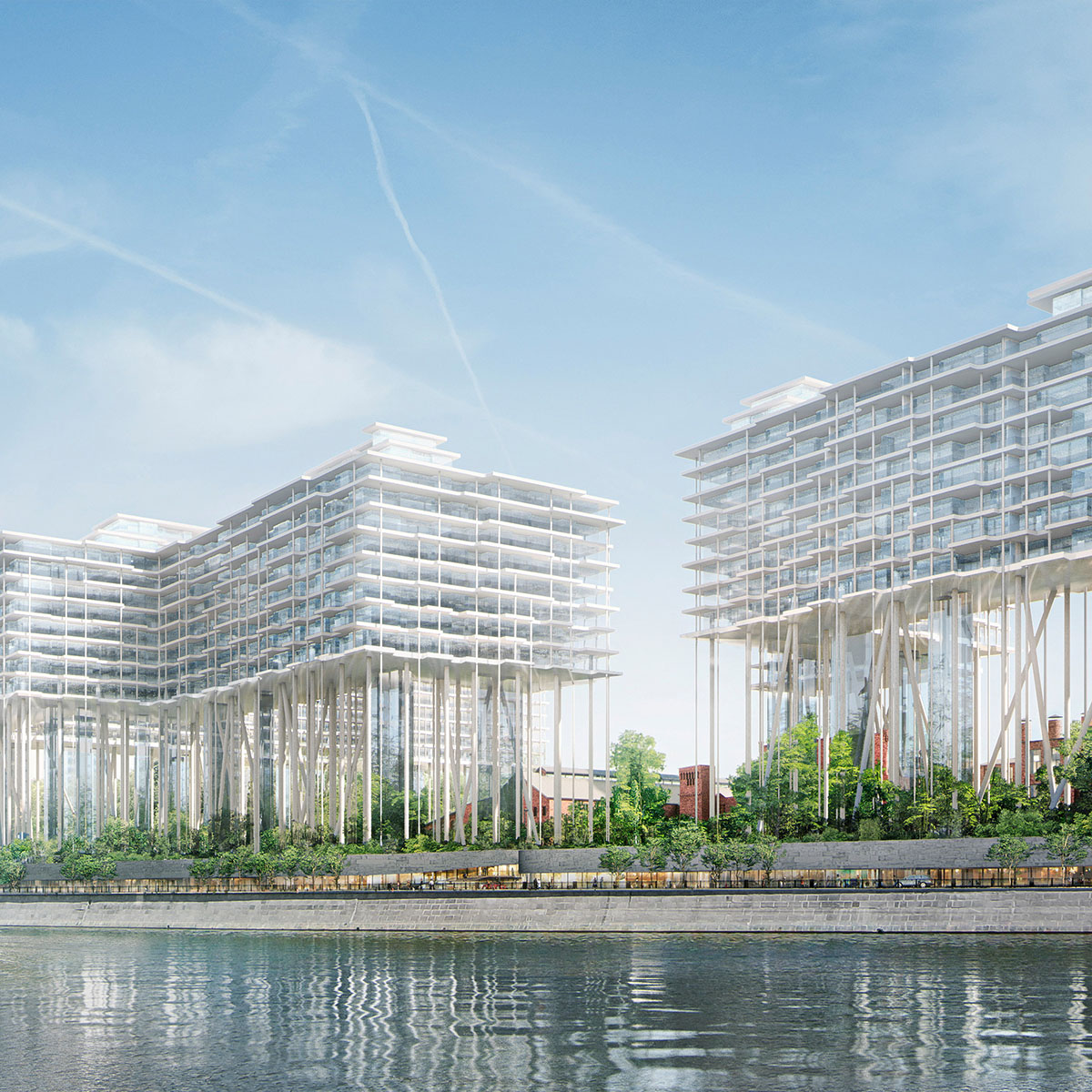
The general conceptual study will oversee the old industrial structures and redevelop the olds factory grounds with river embankment, as well as restoring more than 30,000-square-metre buildings within a vast renovation plans. Herzog & de Meuron's new residential blocks, encompassing a total of 100,000-square-metre area, will add a new mixture of program consisting of office and retail units to rejuvenate the whole site to create a balanced-quality between residential, work and recreation.
"Moscow is a city with a rich and controversial cultural and political heritage, with architectures reflecting avant-garde as well as conservative trends in the course of history," said Herzog & de Meuron in a project description.
"Our project for the redevelopment of Badaevskiy factory inserts itself in this very history and tradition of Moscow urbanism – it respects and re-uses existing industrial buildings while adding and overlaying them with radically contemporary structures," the firm added.
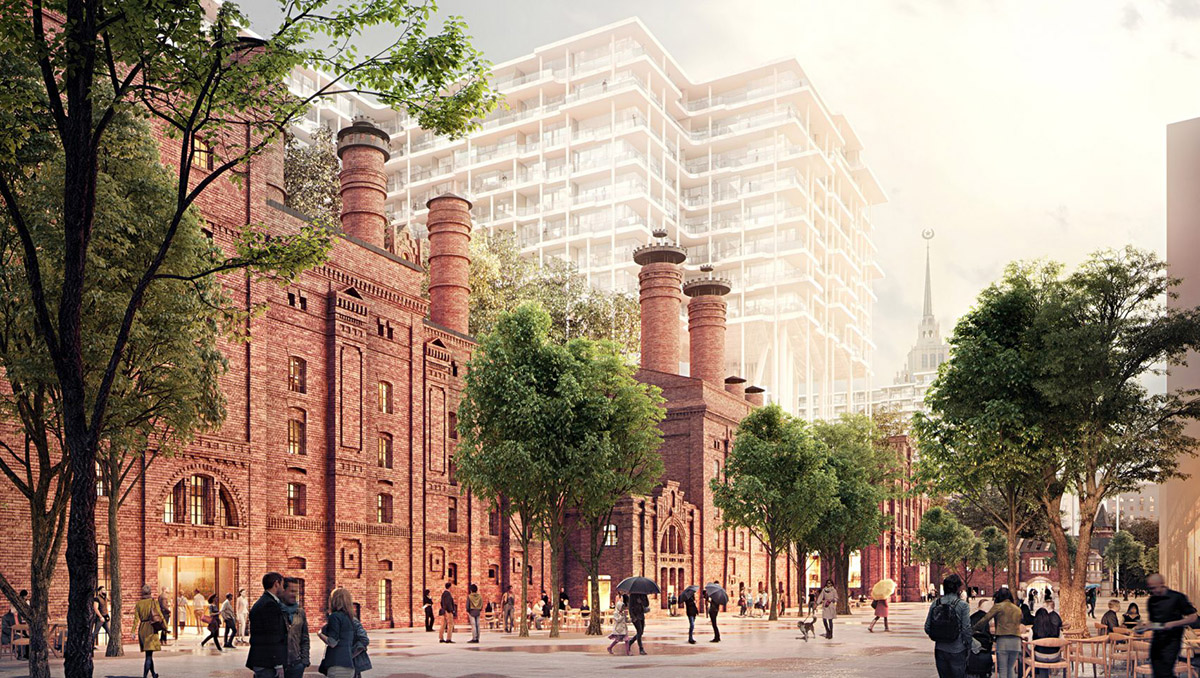
The old brewery site was closed in the 2000s and the buildings remained as ruin and largely abandoned despite sporadic uses. Today, the site contains the three original main factory buildings: Building 1, built between 1875 and 1912, a Russian Romantic Revival arcaded building is located on the eastern part of the plot - and Building 3 has an English style industrial cluster with characteristic silos on the western end that is still remain.
Building 2, which is conceived as the centrepiece of the historic ensemble, was lost. According to the current urban and heritage regulations, Building 1 and Building 3 have been given cultural heritage status and required preservation for their original brick factory structures.
The Swiss architect will redevelop the remaining part of the site and open it to the public, within a height restriction of 75 metres. "Under these regulations, the project undergoes a series of consultations with authorities and municipal specialists, and heads toward an Expertiza process and Construction Permit," stated the firm.
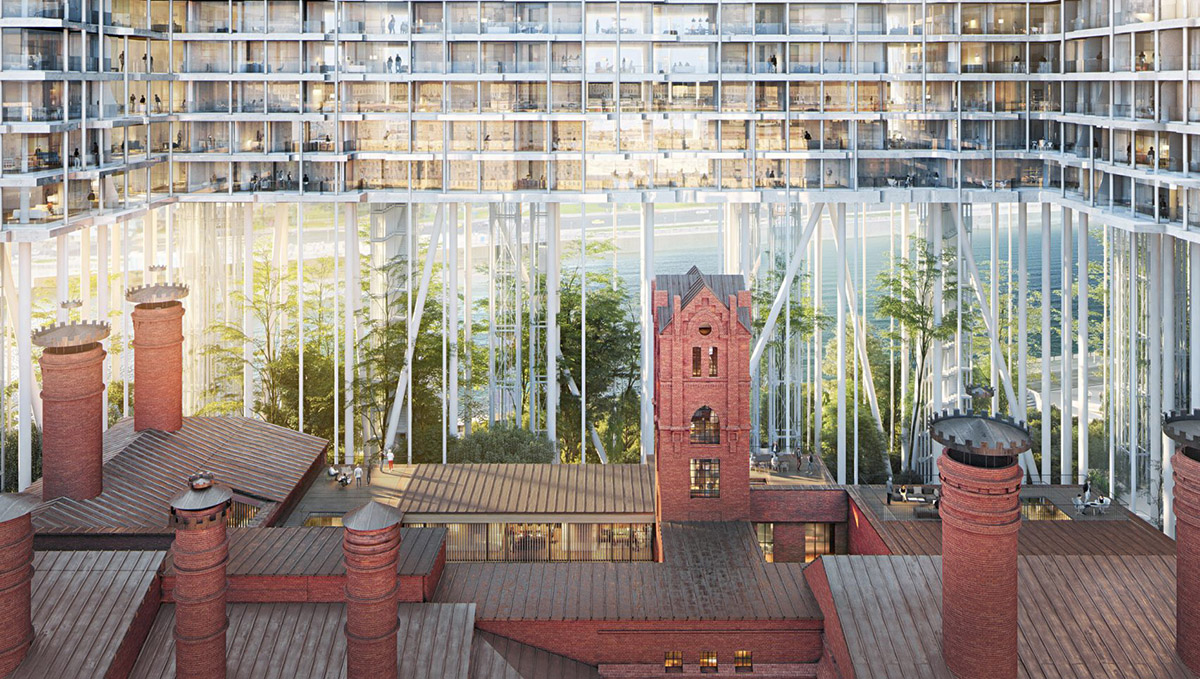
The studio is inspired by the found structures and the history of the site, and the heritage site inspires the architects to create elegantly-designed urbanistic and architectural interventions, that' why, the architects elevate the whole residential complex 35 meters above the ground, as well as the spatial continuity of the park and to create gardens beneath.
"We found it extraordinary and especially appealing to use the opportunity to push such a radically different urbanistic approach in a city which has traditionally preferred tabula rasa concepts, in the Soviet as well as the post-Soviet periods, as so perfectly demonstrated by the nearby examples of the 206-metre high Ukraina Hotel (one of the iconic Moscow Seven Sisters high-rises), the Kutuzovskiy neoclassical blocks, and the more recent 350-metre high Moscow City," they explained.
Through the clearing of the unimportant and unprotected structures, the studio will open the site for the first time, to the city and the neighbourhood. A new park will be connected to the site with the river, to reveal the heritage buildings and make them more accessible.
The architects will re-function the Building 1, a pair of historical structures of 20,000-square-metre areas, as a food market, fashion store, co-working space with conference centre and a large gym. These diverse functions will be united by connected central atriums and covered by top-light wooden roofs, be adapted according to their original geometry. Building 2, the lost heart of the complex, is built anew in solid brick to its original design, following historical documents.
The buildings’ rear facades, revealed after the demolishing of the support structures and opened now to the park and the river, will continue as the solid brick materiality and reflect the new internal organization of the buildings.
The architects described the new buildings as "a piece of city lifted up in the air", so that's why, they called the complex as "Horizontal Skyscraper", since it may be the most accurate statement that can described the project.
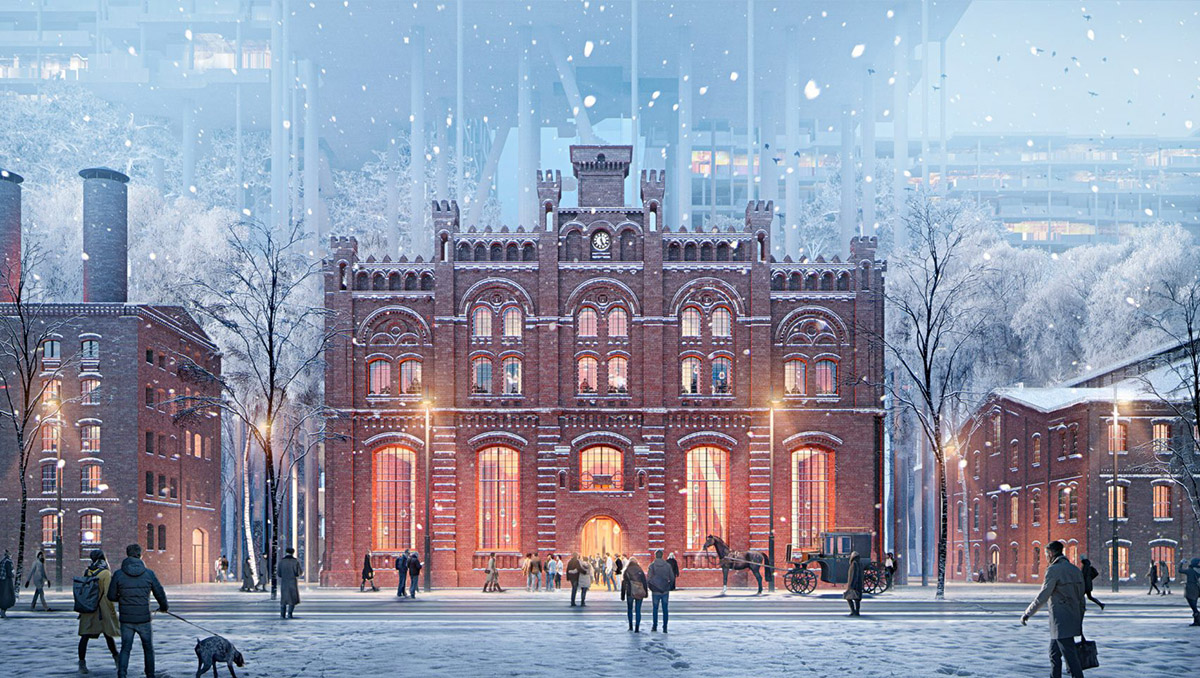
"The greatest problem was that any new structure on the ground would have divided the site into privileged and less privileged areas, into front and back sides, and the amount of public green would have been reduced to a minimum. It was obvious that we started to lift up in the air the piece that we had tested on the ground before, although we were hesitant to come up with a building typology which is so remindful of the "Wolkenbügel", one of the most heroic icons of the Russian Avant-garde," they added.
"But here it didn't look heroic or monumental. The building does not fly; it rather sits on many slender stilts like an elevated lodge in the forest. The stilts connect the building with the ground and the park like trunks of trees."
"The single operation of elevating the new building 35 metres up in the air brings three key advantages for the project: first, the new green area, an urban park, emerges in the vacated land under the hovering structures, between the heritage buildings and the river front."
"Second, despite the substantial densification of the site, the historical buildings retain their direct connection to the river and their clear visibility and access to the city; and third, all the flats in the hovering structure are top floors with prime views to the Brewery, Kutuzovskiy Prospekt, Ukraina Hotel, the State Duma, Moscow City, and beyond to greater Moscow. Running along the riverfront plot line, the new lifted building follows the outlines of the heritage structures and the established north-south orientation of the old industrial grid."
"The resulting undulating form resembles the geometry of the meandering waterfront buildings in this part of historical Moscow and maximizes the views out to the river," explained the architects.
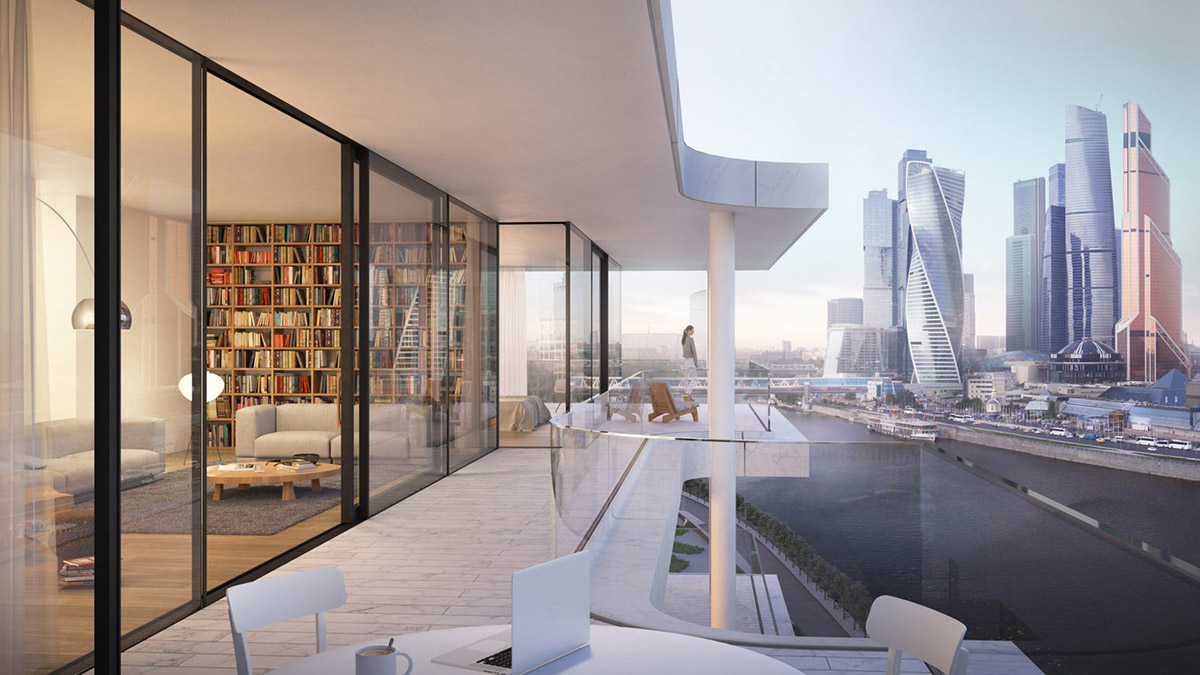
The apartments will highly be individualized in terms of layout and facade expression and command sweeping panoramic views with their fully glazed facades. Each apartment will feature a large balcony, a truly private exterior space in the centre of Moscow.
The architects designed the largest external spaces on the roof, belonging to the eight sky villas, where rooftop gardens complete the top of the hovering building. A single underground complex on three floors will inhabit the entire site, connect and serve all the buildings and provide the required parking, delivery and support facilities.
A new big urban park will be the heart of the regeneration plan, to be "a place for all". Along the Moscow River, the urban park will be a highly attractive stretch of promenade and boulevard with restaurants, bars and shops.
Between that river promenade and Kutuzovskiy Prospekt, the studio will implement a new landscape and maximise the green areas with transitions between public, semi-public and private zones, by following gradual shifts from lawn areas, to low greenery, to high forest-like planting.
The entire site is designed to be exclusively pedestrian and permeable, providing easy and direct public access from the river promenade to the microcosm of activities in the new Badaevskiy Brewery project.
The conceptual study is still in the planning process and any planned completion date and the start of construction date are not being announced by the firm. The plans will be redeveloped in stages.
Project facts
Herzog & de Meuron Project Team:
Partners: Jacques Herzog, Pierre de Meuron, Stefan Marbach (Partner in Charge)
Project Team: Olga Bolshanina (Associate, Project Director), Tomislav Dushanov (Associate, Project Director), Sjoerd Zonderland (Project Manager), Fanny Christinaz (Project Manager), Marcelo Bernardi (Associate).
Alix Biehler, Mario Bonilla, Mathieu Breton-Ortuno, Marcello Carpino, Massimo Corradi, Gwendoline Eveillard, Diogo Figueiredo, Pablo Garrido, Bryan Grossenbacher, Hamit Kaplan, Petr Khraptovich, Simina Marin, Magnus Möschel, Ilia Moiseev, Alexandros Mykoniatis, Dulcineia Neves dos Santos, Thanh Nguyen, Lukas Nordström, Poap Panusittikorn, Romain Péquin, Marika Prete, Marie-Louise Raue, Derya Sancar, Dmitry Stolbovoy, Victor Stolbovoy, Andrew Tétrault, Emma Thomas, Ramona Triolo, Ilia Stefanov Tsachev, Harry M.X. Wei, Michal Baurycza (Visualisations), Mikolaj Bazaczek (Visualisations), Massimo Corradi, Bruno de Almeida Martins (Visualisations), Holger Rasch.
Client: Capital Group, Moscow, Russia
Planning: Executive Architect: Apex Project Bureau, Moscow, Russia
Building Services Engineering: Unidraft, Moscow, Russia
Landscape Design: Vogt Landscape Limited, London, UK
Structural Engineering (International Consultant): Schnetzer Puskas Ingenieure AG, Basel, Switzerland
Structural Engineering (Local Consultant): Apex Project Bureau, Moscow, Russia
Consulting:
Acoustics: Apex Project Bureau, Moscow, Russia
Facade Engineering (International Consultant): Emmer Pfenninger Partner AG, Basel, Switzerland
Facade Engineering (Local Consultant): Apex Project Bureau, Moscow, Russia
Fire Protection: Apex Project Bureau, Moscow, Russia
All images courtesy of Herzog & de Meuron
> via Herzog & de Meuron
